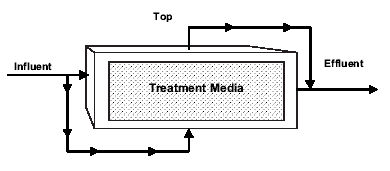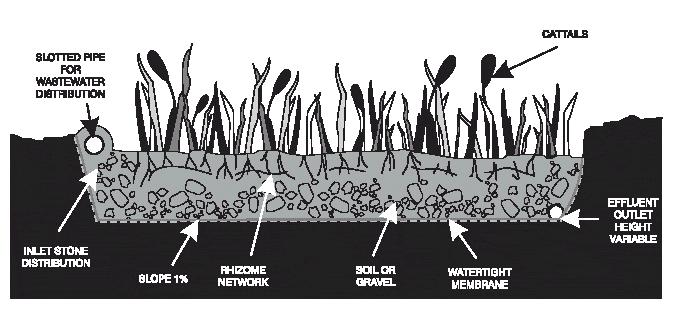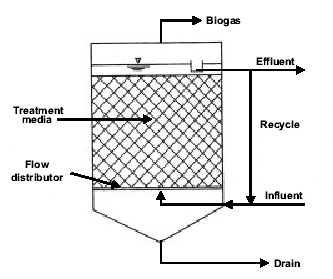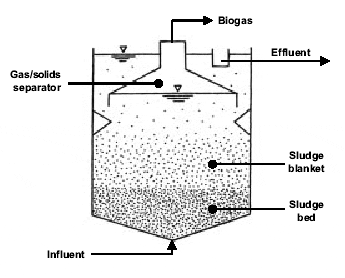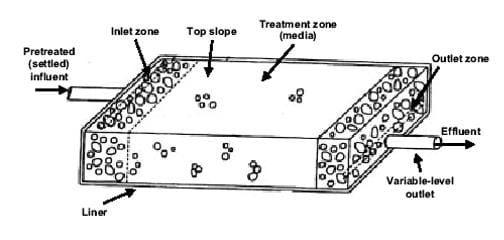 Vegetative Submerged Bed Septic System Designs
Vegetative Submerged Bed Septic System Designs
- POST a QUESTION or COMMENT about submerged bed septic system designs
Submerged bed septic system designs:
This document discusses Vegetative submerged bed septic system design applications and High-Specific-Surface Anaerobic Reactors for septic systems, a variation for septic system effluent final treatment and disposal.
InspectAPedia tolerates no conflicts of interest. We have no relationship with advertisers, products, or services discussed at this website.
- Daniel Friedman, Publisher/Editor/Author - See WHO ARE WE?
Vegetated Submerged Beds and Other High-Specific-Surface Anaerobic Reactor Septic System Designs
Description of Vegetated Submerged Bed Septic System Designs
Onsite Wastewater Treatment Systems Technology Fact Sheet 5 - EPA 625/R-00/008 - We have expanded original US EPA information with supplemental documentation, references, and comments.
A high-specific-surface anaerobic reactor (figure 1) is any tank or cavity filled with solid media through which wastewater flows with a high hydraulic retention time (HRT). In onsite treatment the two primary types are vegetated submerged beds (VSBs) and anaerobic upflow filters (AUFs).
The first is characterized by horizontal flow and prolific growth of macrophytes on the surface. The second comes in a variety of forms from upflow sludge blanket systems and fixed media anaerobic filters to partially fluidized beds of fine media. Both have long HRTs, produce anaerobic effluents, generally treat either high-strength or minimally pretreated wastewater, and usually require some form of post treatment to meet surface discharge or water reuse requirements.
Figure 1. Generic high-specific surface anaerobic reactor
The primary removal mechanisms in all of these systems are physical, that is, floculation, sedimentation, and adsorption.
Anaerobic biological reactions are extremely slow and do not have a significant impact on soluble BOD until HRTs become quite long. Some toxic organic compounds may be reduced through these mechanisms and chemical precipitation (e.g., sulfides) at shorter HRTs.
VSBs, as shown in figure 2, usually follow a septic tank and remove most of the suspended and larger colloidal particles, BOD, organic forms of nitrogen, and other particles. Although they are frequently identified as subsurface constructed wetlands, they do not fit the strict definition of a constructed wetland.
Figure 2. Elements of a vegetated submerged bed (VSB) septic systems
Source: Toms Creek Project, VA.
Three types of AUFs can be used as pretreatment devices for high-strength wastewater and some onsite pretreatment applications in the United States. They are in shown in figures 3, 4, and 5. Figure 3, with a rock medium, is the most typical U.S. application.
Figure 3. Schematic of the upflow anaerobic filter process used in Vegetated Submerged Bed Septic System Designs
Figure 4. Schematic of the upflow anaerobic sludge blanket process used in Vegetated Submerged Bed Septic System Designs
Figure 5. Schematic of the anaerobic fluidized bed process used in Vegetated Submerged Bed Septic System Designs
Typical applications of Vegetated Submerged Bed Septic System Designs
AUFs are widely used in hot climates where domestic wastewaters are several times higher in strength than U.S. wastewaters. These systems can reduce high BOD and TSS to levels that can be readily treated by typical aerobic processes such as suspended and fixed growth aerobic units or recirculating/intermittent media filters.
International literature contains numerous references to the three types of AUFs and their valuable contributions to water pollution abatement. Anaerobic rock upflow filters (figure 6) are also used to lower septic tank effluent BOD and TSS concentrations prior to discharge to the subsurface wastewater infiltration system (SWIS).
Figure 6. Anaerobic upflow filter for Vegetated Submerged Bed Septic System Designs
VSBs are extremely popular in the United States because of their aesthetic features and their ability to meet basic (secondary) effluent standards when treating septic tank effluent. Until recently they were purported to be capable of nitrification and nutrient removal at economically competitive HRTs. Since they are largely anaerobic, this would be biochemically impossible.
However, they are fully capable of meeting secondary BOD and TSS standards. They are also sometimes used before a SWIS and can meet the same effluent TSS and BOD standards as aerobic units (Technology Fact Sheets 1, 2, and 3). VSBs can be considered as pretreatment units regarding SWIS design requirements. They do not, however, remove more than 2 logs of fecal coliform and would likely require disinfection for direct surface discharge. They also require some form of aeration to meet effluent standards for dissolved oxygen (DO). These VSBs will capture rainfall and snowmelt, effluent standards for requiring adjustment to designs of SWIS following these units.
Both VSBs and AUFs are being used in rural areas in combination with aerobic processes to remove significant amounts of nitrogen through denitrification. These processes are included in the nutrient removal fact sheets.
Design assumptions for Vegetated Submerged Bed Septic System Designs
VSB design guidance for small communities is provided in table 1. In the first few months of operation, excellent phosphorus removal will occur until the rock medium becomes saturated with phosphorus and breakthrough occurs. (Note: USEPA guidance on design of VSBs can be found in Manual: Constructed Wetlands Treatment of Municipal Wastewater, posted at http://www.epa.gov/nrmrl/pubs/625r99010/625r99010.pdf)
Table 1. Summary of VSB Septic System Design Guide
| Pretreatmenta | Objective |
| Surface area BOD TSS TKN TP |
Based on desired effluent quality and area loading rates as follows: 6 g/m2-d (53.5 lb/ac-d) to attain 30 mg/L effluent 1.6 g/m2-d (14.3 lb/ac-d) to attain 20 mg/L effluent 20 g/m2-d (178 lb/ac-d) to attain 30 mg/L effluent Use another treatment process in conjunction with VSB VSBs not recommended for phosphorus removal |
| Depth Media (typical) Water (typical) |
0.5 - 0.6 m (20 - 24 in) 0.4 - 0.5 m (16 - 20 in) |
| Length | Minimum of 15 m (49 ft.) |
| Width | As calculated |
| Bottom slope | 0 - 1% |
| Top slope | Level or nearly level |
| Hydraulic conductivity First 30% of length Last 70% of length |
1% of clean K 10% of clean K |
| Media Inlet zone (1st 2 m [6.5 ft]) |
All media should be washed clean of fines and debris; more uniform rounded media will generally have more void spaces; media should be resistant to crushing or breakage. 40 - 80 mm (1.5 - 3.0 in) 20 - 30 mm (3/4 - 1 in) use clean K = 100,000, if actual K not known 40 - 80 mm (1.5 - 3.0 in) 5 - 20 mm (1/4 - 3/4 in) |
| Miscellaneous | Use adjustable outlet control device with capability to flood and drain system and sizing of VSB and SWIS (if used) must include a water balance analysis |
Notes to the table above
a Use after primary sedimentation (e.g., septic tank, Imhoff tank, primary clarifier); not recommended for use after ponds because of problems with algae.
Except for the anaerobic upflow rock filter, AUFs are rarely employed for U.S. onsite applications. Since the primary purpose of these systems is to improve the BOD and TSS of septic tank effluent, they are essentially physical processes.
Therefore, they must be designed to maximize their flocculation and sedimentation functions. Limited field studies indicate that successful removal of particulate BOD and TSS could be obtained with an average HRT between 16 and 24 hours, rounded media size of 1 to 2 inches or greater, and a means of periodically draining excess accumulated solids from the bottom of the unit. At higher temperatures, some partial digestion of accumulated organic solids occurs. This liquefaction may by accompanied by gas production. The amount and makeup of that gas depend on pH, wastewater constituents (e.g., protein, lipids, carbohydrates), sulfate, alkalinity, and other constituents.
Performance of Vegetated Submerged Bed Septic System Designs
VSB systems can treat septic tank effluent to a BOD of 20 to 30 mg/L, depending on the organic loading rate chosen.
The VSB effluent TSS is almost always less than 30 mg/L. Some removal of all constituents (e.g., heavy metals, organic nitrogen and organic phosphorus, pesticides, and other toxic organics) can also be expected. Over and above these removals, there will be some small percentage of dissolved organic removal owing to anaerobic biological activity.
Rock AUFs after septic tanks have not been widely studied, but they appear to remove TSS by as much as 55 percent from septic tank effluent, while removing a similar percent of the BOD. Actual removals will depend on the specific fractions of particulate, colloidal, and soluble matter in the septic tank effluent. Little soluble or fine particulate removal is likely.
Both systems will remove pathogens, with VSBs capable of removing from 1 to 3 logs (design average = 2 logs), while AUF removal is estimated to be closer to 1 log because of shorter HRTs.
Management needs for Vegetated Submerged Bed Septic System Designs
All of these anaerobic systems are passive in nature and require minimal O/M activity. AUF units may be constructed aboveground, but they usually are below the ground surface to provide insulation and protect against severe climatic conditions.
The solid medium can be a coarse gravel or one of many commercially available synthetic media that will not easily clog with biomass. Access to inlet and outlet systems should be provided for purposes of cleaning and servicing. An easily accessible means to drain the unit and an effective alarm system should be provided.
VSB units are generally aesthetically pleasing additions to the landscape if sufficient area is available for their application. It is estimated that fewer than 4 hours per year will be required for O/M tasks, which will involve inspecting the system and making any adjustments required. Therefore, until more information becomes available, a site visit schedule of three to four times a year is suggested.
Residuals generate in VSB systems at a slow rate. Although the system inlet where most solids accumulate can be excavated or piped for high-pressure removal, it is more likely that a replacement system would be built after the service life of the original system ends.
AUF units will require periodic flushing of accumulated solids and inspection of inlet and outlet systems. If solids are allowed to accumulate, the filter may clog or release high solids "events" to the SWIS. This will clog the infiltrative surface or the distribution system. Therefore, a site visit schedule of three to four times per year is suggested until more information becomes available. This would entail from 6 to 8 hours per year of labor. Disposal and transport of excess solids will require similar management to septage.
Risk Management Issues Concerning Vegetated Submerged Bed Septic System Designs
VSB systems can usually handle the flow variations likely to occur from residential sources, as well as toxic shock loads and power outages. Reed and colleagues (1995) proposed some models to support the view that insulation provided by dead vegetation (litter) on the surface should aid these systems during typical winters in northern climates. The potential for odor is low for properly sized systems.
AUF systems should also accommodate typical flow variations, toxic shocks, and power outages. They should be insulated from cold weather. AUFs are inherently odor and corrosion generators, so corrosion-resistant materials should be employed. Odor (hydrogen sulfide) production may require the use of an odor-control system (e.g., soil filters) to deodorize off-gases.
Typical Costs of Vegetated Submerged Bed Septic System Designs
VSB systems for onsite application will cost about $20 per square foot (USEPA, 1999). Almost half of that cost is for the media, while excavation, liner, plants, control structures, and piping make up the rest. Operation and maintenance costs would run less than $100 per year if these services are professionally provided.
AUF systems are likely to cost about $1,000 to $1,500 per house, primarily related to the cost of the tank and related containment features. O/M costs would run around $200 per year, including solids transport as required.
Vegetated Submerged Bed Septic System Designs, References & Products
- Bauer, D.H., E.T. Conrad, and D.G. Sherman. 1979. Evaluation of Onsite Wastewater Treatment and Disposal Options. EPA/600/s2-81-178. U.S. Environmental Protection Agency, Cincinnati, OH.
- Cowlter, J.B., S. Soneda, and M.B. Ettinger. 1957. Anaerobic contact process for sewage disposal. Sewage and Industrial Wastes Journal 29(4):468-477.
- Crites, R., and G. Tchobanoglous. 1998. Small and Decentralized Wastewater Management Systems. WCB McGraw-Hill, San Francisco, CA.
- DeRenzo, D.J. 1977. Energy from Bioconversion of Waste Materials. Noyes Data Corporation, Park Ridge, NJ.
- Hamilton, J. 1975. Treatment of Septic Tank Effluent with an Anaerobic Filter. Master's of Science in Civil Engineering thesis, University of Washington, Seattle.
- Hamilton, J. 1976. Proceedings of Northwest Onsite Wastewater Disposal Short Course. University of Washington, Seattle.
- Jewell, W.J. 1987. Anaerobic sewage treatment. Journal of Environmental Science and Technology 21(1):14- 21.
- Kennedy, J.C. 1979. Performance of Anaerobic Filters and Septic Tanks Applied to the Treatment of Residential Wastewater. Master's thesis, University of Washington, Seattle.
- Lombardo & Associates, Inc. 1983. Design Report. Anaerobic Upflow Filters. Newton, MA.
- Netter, R., E. Stubner, P.A. Wildner, and I. Sekoulov. 1993. Treatment of septic tank effluent in a subsurface biofilter. Water Science Technology 28(10):117-124.
- Reed, S.C., R.W. Crites, and E.J. Middlebrooks. 1995. Natural Systems for Waste Management and Treatment. McGraw Hill, Inc, New York.
- Switzenbaum, M.S. 1985. Proceedings of Seminar/Workshop-anaerobic Treatment of Sewage. Report No. Env.E. 88-85-5. University of Massachusetts, Amherst, MA.
- Thaulow, H. 1974. Use of Anaerobic Filters for Onsite Treatment of Household Wastewater. Master's thesis, University of Washington, Seattle.
- U.S. Environmental Protection Agency (USEPA). 1992. Wastewater Treatment/Disposal for Small Communities. EPA 625/R-92-005. U.S. Environmental Protection Agency, Cincinnati, OH.
- U.S. Environmental Protection Agency (USEPA). 1993a. Nitrogen Control Manual. EPA 625/R-93/0010. U.S. Environmental Protection Agency, Office of Research and Development, Washington, DC.
- U.S. Environmental Protection Agency (USEPA). 1993b. Subsurface Flow Constructed Wetlands for Wastewater Treatment: A Technology Assessment. EPA 832-R-93-008. U.S. Environmental Protection Agency, Office of Water, Washington, DC.
- U.S. Environmental Protection Agency (USEPA). 1999. Manual: Constructed Wetlands Treatment of Municipal Wastewater. EPA 625/R-99/010. U.S. Environmental Protection Agency, Cincinnati, OH
...
Continue reading at WETLAND SEPTIC SYSTEMS or select a topic from the closely-related articles below, or see the complete ARTICLE INDEX.
Or see
SEPTIC SYSTEM DESIGN ALTERNATIVES - home
SEWAGE TREATMENT PLANTS, RESIDENTIAL - types of residential level wastewater treatment plants & methods
Suggested citation for this web page
VEGETATED SUBMERGED SEPTIC BEDS at InspectApedia.com - online encyclopedia of building & environmental inspection, testing, diagnosis, repair, & problem prevention advice.
Or see this
INDEX to RELATED ARTICLES: ARTICLE INDEX to SEPTIC SYSTEMS
Or use the SEARCH BOX found below to Ask a Question or Search InspectApedia
Ask a Question or Search InspectApedia
Questions & answers or comments about submerged bed septic system designs.
Try the search box just below, or if you prefer, post a question or comment in the Comments box below and we will respond promptly.
Search the InspectApedia website
Note: appearance of your Comment below may be delayed: if your comment contains an image, photograph, web link, or text that looks to the software as if it might be a web link, your posting will appear after it has been approved by a moderator. Apologies for the delay.
Only one image can be added per comment but you can post as many comments, and therefore images, as you like.
You will not receive a notification when a response to your question has been posted.
Please bookmark this page to make it easy for you to check back for our response.
IF above you see "Comment Form is loading comments..." then COMMENT BOX - countable.ca / bawkbox.com IS NOT WORKING.
In any case you are welcome to send an email directly to us at InspectApedia.com at editor@inspectApedia.com
We'll reply to you directly. Please help us help you by noting, in your email, the URL of the InspectApedia page where you wanted to comment.
Citations & References
In addition to any citations in the article above, a full list is available on request.
- New York State Department of Health, APPENDIX 75-A WASTEWATER TREATMENT STANDARDS - INDIVIDUAL HOUSEHOLD SYSTEMS , [PDF] New York State Department of Health, 3 February 2010, retrieved 3/1/2010, original source: https://www.health.ny.gov/regulations/nycrr/title_10/part_75/appendix_75-a.htm
- US EPA Onsite Wastewater Treatment Systems Manual - original citation epa.gov/nrmrl/pubs/625r00008/html/625R00008.htm and for vegetative submerged bed septics, see EPA http://www.epa.gov/nrmrl/pubs/625r00008/html/tfs5.htm
- InspectAPedia.com® - Daniel Friedman - Publisher & Editor.
- Construction Guidelines for Gravity and Flood-Dose Trench Onsite (Septic) Systems, Indiana state health department
- Maintenance of Low Pressure Distribution Septic Systems, Vermont Cooperative Extension
- Dosing Gravity Drainfield Systems, Recommended Standards and Guidance for Performance, Application, Design, and Operation & Maintenance, Washington State Department of Health, July 1, 2007
- In addition to citations & references found in this article, see the research citations given at the end of the related articles found at our suggested
CONTINUE READING or RECOMMENDED ARTICLES.
- Carson, Dunlop & Associates Ltd., 120 Carlton Street Suite 407, Toronto ON M5A 4K2. Tel: (416) 964-9415 1-800-268-7070 Email: info@carsondunlop.com. Alan Carson is a past president of ASHI, the American Society of Home Inspectors.
Thanks to Alan Carson and Bob Dunlop, for permission for InspectAPedia to use text excerpts from The HOME REFERENCE BOOK - the Encyclopedia of Homes and to use illustrations from The ILLUSTRATED HOME .
Carson Dunlop Associates provides extensive home inspection education and report writing material. In gratitude we provide links to tsome Carson Dunlop Associates products and services.


